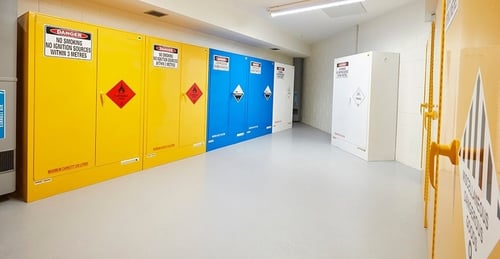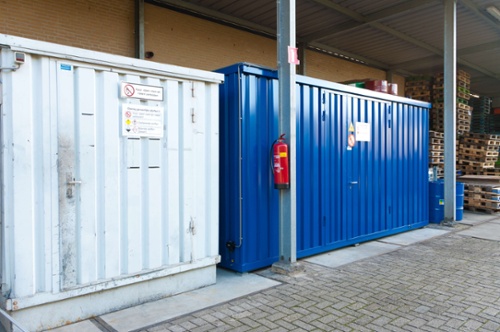If your organisation uses hazardous chemicals, the Work Health and Safety (WHS) Regulations require you to store them in a safe and compliant manner. However, selecting the right storage solutions to control the risks associated with hazardous chemicals can be a difficult task due to the range of factors that must be considered. This post is focused on helping you select the right chemical storage for your workplace by considering some key factors.
But, before we discuss the selection criteria, let’s discuss how to correctly identify and assess the risks associated with your hazardous chemicals. Afterall, if you can’t identify and assess chemical risk, you won’t have the necessary information to implement a successful chemical storage solution.
Identify Hazardous Chemicals
Before you implement a hazardous substance storage solution, you need to identify the hazardous chemicals that are being used in your workplace. This can be achieved by checking the label and safety data sheet for each hazardous chemical onsite.
There are a variety of different substances that you may find in your workplace, including:
- Explosive Substances
- Flammable Gases
- Flammable and Combustible Liquids
- Flammable Solids
- Oxidising Agents
- Organic Peroxides
- Toxic Substances
- Corrosive Substances
Each classification of hazardous substances present different risks upon the people, property and environment of your organisation. Identifying the classification of the hazardous substances will allow you to determine a suitable storage solution that will reduce the specific risks presented by the hazardous substances being used in your workplace.
Assess Risks
Once you have identified all the hazardous substances that are being used in your workplace, you must then conduct a risk assessment. A risk assessment allows you to determine the magnitude of the risks associated with specific hazardous substances that you have stored in your workplace.
The magnitude of the risk can be determined by calculating the severity of an incident and the likelihood of it occurring.
Risk = Severity of outcomes x Likelihood of the incident
Carrying out a risk assessment will allow you to determine the level of risk and the necessary controls that will be required to reduce the risk associated with the hazardous chemicals.
Selecting The Right Storage Solution
Once you have identified and assessed the risks associated with the hazardous substances that are being used in your workplace, you will be in a good position to implement a successful hazardous substance storage solution.

The identification and assessment of risk is an important first step when determining chemical storage for your workplace.
A successful hazardous substance storage solution is one which reduces the risks that the hazardous substances pose.
Some aspects to be considered when choosing a suitable storage method for hazardous materials include:
- Compliant construction of storage facilities
- Storage that is applicable for the chemical’s dangerous goods class
- Solutions which are suitable for the environment in which it will be installed
We’ll now discuss these aspects for hazardous chemical storage selection in more detail below.
Chemical Storage Must Be Compliant
When implementing a hazardous substance storage solution in your workplace, it’s important to check that the solution complies with regulation. Failure to comply with regulation will put your organisation at risk of liability — as well as the human, environmental and financial costs associated with an onsite incident.
To ensure that your storage solution is compliant, it must be designed and manufactured in full conformance to the relevant Australian Standard. While the Australian Standards are not law, they are an invaluable resource that will help you meet WHS compliance.
There are 9 different dangerous goods classifications, with an applicable Australian Standard for each:
| CHEMICAL STORAGE CLASSES | AUSTRALIAN STANDARD |
| Class 1 Explosives | AS 2187.1 - Explosives Storage, transport and use |
| Class 2 Gases | AS 4332 - The storage and handling of gases in cylinders |
| Class 3 Flammable Liquids | AS 1940 - The storage and handling of flammable and combustible liquids |
| Class 4 Flammable Solids |
AS/NZS 5026 - The storage and handling of class 4 dangerous goods |
| Division 5.1 Oxidising Agents | AS 4326 - The storage and handling of oxidising agents |
| Division 5.2 Organic Peroxides | AS 2714 - The storage and handling of organic peroxides |
| Division 6.1 Toxic Substances | AS/NZS 4452 - The storage and handling of toxic substances |
| Class 8 Corrosive Substances | AS 3780 - The storage and handling of corrosive substances |
| Class 9 Miscellaneous Dangerous Goods | AS/NZS 4681 - The storage and handling of class 9 dangerous goods and articles |
Storing Hazardous Chemicals By Class
A dangerous goods storage solution must be suitable for the specific hazardous substances that are being stored within the facility. All dangerous substances pose different risks upon people, property and the environment and each store must be constructed in a way that mitigates the specific risks associated with the hazardous substances being stored.
For example, if a dangerous goods storage facility was manufactured to store Class 3 Flammable Liquids, it won’t be suitable for the storage of corrosive substances.
Class 3 chemicals are volatile substances that give off flammable vapours, while corrosive substances are chemicals that break down other materials such as metal and stone. The features that are required to reduce the risk of flammable liquids are different to those required to reduce the risk of corrosive substances.
Hazardous materials storage must be suitable for the class of chemical being stored.
Due to the risk of ignition, storage for Class 3 substances must be constructed from non-combustible materials. One the other hand, Class 8 Corrosive cabinets or outdoor stores must be constructed from a non-corrosive material or coated with a corrosive-resistant lining to protect it from corrosive vapours.
REMEMBER: Chemical storage classes are an essential consideration when selecting Hazchem storage equipment. To ensure safety and compliance, make sure that your storage equipment is suitable for the hazardous chemicals that you’re storing – and that it’s designed and constructed to reduce all the specific hazards posed by the substances.
Suitable For The Location
Another factor that you must consider when implementing hazardous chemical storage solutions is whether the storage facility is suitable for the environment in which it will be installed.
The design and construction requirements of dangerous goods storage facilities will depend on the surrounding environmental conditions.
For example, if you were seeking to store Class 3 liquids indoors, you will require a different storage facility to what would be suitable for the outdoor storage of flammable liquids. Outdoor stores are generally constructed for the storage of larger volumes of hazardous materials, while indoor flammable cabinets are designed for the safe storage of Class 3 chemicals in smaller quantities.
There are key differences in the design and construction of indoor and outdoor chemical storage facilities.
In addition to this, outdoor stores must provide protection against the elements, as well as the added risks associated with chemical storage in the outdoor environment. Natural ventilation is required due to the larger volume of chemicals stored, as well as failsafe security to prevent unauthorised entry and theft. Weather conditions, such as sun, wind, rain and extreme temperatures, require a more robust store that is capable of shielding the chemicals from these elements. Outdoor stores often feature heavy duty coatings to protect the store from corrosion.
Some Examples of the Correct Hazardous Chemical Storage
Referencing the list of hazardous chemicals that we mentioned at the top of this article, here’s a basic list of some dangerous goods storage equipment that meet the requirements of the Australian Standards, as well as the needs of the environment in which the storage is located:
|
CHEMICAL |
INDOORS |
OUTDOORS |
|
Explosive Substances |
Class 1 cabinet |
Class 1 explosive storage day box |
|
Gases |
Indoor storage not recommended |
Gas cylinder cage, LPG bottle store |
|
Flammable Liquids |
Class 3 cabinet |
Class 3 chemical storage container, Class 3 dangerous goods container, temperature controlled storage if applicable |
|
Flammable Solids |
Class 4 cabinet |
Class 4 chemical storage container, Class 4 dangerous goods container |
|
Oxidising Agents |
Class 5.1 cabinet |
Class 5.1 chemical storage container, Class 5.1 dangerous goods container, temperature controlled storage if applicable |
|
Organic Peroxides |
Class 5.2 chemical storage container, Class 5.2 dangerous goods container, temperature controlled storage if applicable15 |
|
|
Toxic Substances |
Class 6 cabinet |
Class 6 chemical storage container, Class 6 dangerous goods container, temperature controlled storage if applicable |
|
Corrosive Substances |
Class 8 cabinet – steel or poly depending on strength of chemical |
Class 8 chemical storage container, Class 8 dangerous goods container, temperature controlled storage if applicable |
IMPORTANT: Temperature controlled stores are required for the storage of volatile, sensitive substances which must be stored in specific conditions. Refer to your safety data sheets and risk assessment to determine if this is a solution that is required for your substances.
Meeting Hazardous Material Storage Requirements
There are many factors that must be considered when storing hazardous chemicals in the workplace. To ensure that you implement a storage solution that actively reduces the risks associated with hazardous chemicals, you must firstly identify and assess the risks associated with the hazardous chemicals stored onsite. Once you have obtained this data, you will be ready to implement a solution to control the risk associated with the hazardous chemical.
To comply with WHS regulations, make sure your storage equipment is manufactured to meet Australian Standards. This will ensure that you’re safely storing hazardous materials to minimise risk. If you’d like more information on storing hazardous chemicals, why not access our FREE eBook by clicking on the image below?
Joining the team as a Dangerous Goods Storage Consultant, Melissa Hampton became Storemasta's Marketing Manager in late 2021. With extensive knowledge and experience in chemical compliance, Melissa is responsible for leading the Marketing team and helping shape their marketing strategy. In her spare time, you can find Melissa hiking, swimming and enjoying the great outdoors in beautiful north-west Tasmania.


